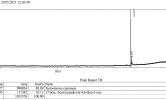unknownpurple88
New Member
I have test E provide by dragonordnance 300mg/ml and i have pip inyected only 0.5ml....
Follow along with the video below to see how to install our site as a web app on your home screen.
Note: This feature may not be available in some browsers.
About 10% using area count approximation.@janoshik if you remember since it's been a few years, what % did that Test Cypionate gcms pickup the d6 isomer at?
Funny that you ask, just today I've detected that, what I also believe to be delta 6 variant, in test cyp raws when I ran the test out of my personal curiosity!@janoshik does this Delta 6 variance only exsist for test e raws? Also, does this variance exsist in any other AAS powder such as Testosterone Cypionate?

It IS allowed in...I assume this is only happening for UGL produced raws and never allowed for true pharmaceutical testosterone e right?
So the test cyp tested the same % as the test enan. This would lead us to believe its not the d6 dimer causing the pip.About 10% using area count approximation.
Funny that you ask, just today I've detected that, what I also believe to be delta 6 variant, in test cyp raws when I ran the test out of my personal curiosity!@janoshik does this Delta 6 variance only exsist for test e raws? Also, does this variance exsist in any other AAS powder such as Testosterone Cypionate?
(ignore the autoassigned name for the impurity)
I mean, what else would Jano do over the weekend, right?
It IS allowed in...I assume this is only happening for UGL produced raws and never allowed for true pharmaceutical testosterone e right?
Two different impurities. We need more info on the Test cyp variant and confirm which USP impurity it was. I can't conclude that from the data presented.So the test cyp tested the same % as the test enan. This would lead us to believe its not the d6 dimer causing the pip.
@readalot it sounded like it was the same d6 impurityFunny that you ask, just today I've detected that, what I also believe to be delta 6 variant, in test cyp raws when I ran the test out of my personal curiosity!
Not sure. He could confirm with targeted MS plus standard.@readalot it sounded like it was the same d6 impurity
Structural impurities testing should be part of comprehensive screening package for raws and finished oils.Looking forward to more conclusions of this issue!
I don't understand a single word, butAbout the PIP... I, in fact, do NOT know if delta 6 causes PIP. It's just a speculation at this point. Maybe somebody here has enough time to scour the journals to see what they say about it, but it's quite possible we'll never know.
Several different amino acids appear to have been labeled as expected given the free radical nature of photoactivated δ6-testosterone

A previously undescribed testosterone metabolite (tentatively identified as either Δ1- or Δ6-testosterone sulfate) was present in significant proportions in all of the non-human apes examined.
I don't understand a single word, but

Analysis of the Steroid Binding Domain of Rat Androgen-Binding Protein*
The site-directed photoaffinity ligand [3H]17β-hydroxy-4,6-androstadien-3-one (δ6-testosterone) was used to label the steroid binding domain of rat androgeacademic.oup.com
New bro science lore: Inject Test no ester with high delta six testosterone to get back like a silverback.So they are getting their test from a bunch of apes? Jk jk
Trouble is that it may form over time, based on some Test E being painless when fresh and then developing PIP 6 months down the line. Makes screening difficult even if you're identifying the correct culprit, which isn't necessarily the case.Structural impurities testing should be part of comprehensive screening package for raws and finished oils.
Don't let them cut corners or make sloppy gear. These people don't care about you and will get away with what you let them get away with. But keep defending them.
Almost like the powder is either extremely hygroscopic And over time it's pulling in water from the atmosphere if it's not stored vacuum sealed or in an oxygen free environment. This maybe causing a degradation or slow conversion to d6 isomer. Similarly if there is any reagents left in the powder after processing if it sits for a long time the reagents may be still causing a reaction and conversion to d6 isomer.Trouble is that it may form over time, based on some Test E being painless when fresh and then developing PIP 6 months down the line. Makes screening difficult even if you're identifying the correct culprit, which isn't necessarily the case.
I'm not a fuckin' nerd so I don't know about any of that. I just know when pin pin Test E sometimes it makes ouch ouch.Almost like the powder is either extremely hygroscopic And over time it's pulling in water from the atmosphere if it's not stored vacuum sealed or in an oxygen free environment. This maybe causing a degradation or slow conversion to d6 isomer. Similarly if there is any reagents left in the powder after processing if it sits for a long time the reagents may be still causing a reaction and conversion to d6 isomer.
NopeAlmost like the powder is either extremely hygroscopic And over time it's pulling in water from the atmosphere if it's not stored vacuum sealed or in an oxygen free environment. This maybe causing a degradation or slow conversion to d6 isomer. Similarly if there is any reagents left in the powder after processing if it sits for a long time the reagents may be still causing a reaction and conversion to d6 isomer.

